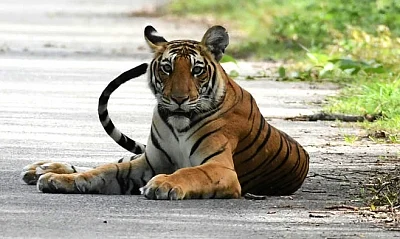New Delhi, Feb 28 (IANS) Indicating the seriousness of the existential threat tigers face across 11 countries, a report said on Wednesday that only 13 per cent of tiger conservation areas meet global standards.As per the report -- released by the World Wildlife Fund (WWF) and other international organisations and inter-governmental panel Global Tiger Forum -- of 112 tiger habitats across Asia and Russia, only 13 per cent meet the global Conservation Assured|Tiger Standards (CA|TS). As many as 85 per cent of tiger habitats lacked patrol staff, says the report.Aiming at doubling the number of wild tigers by 2020 as adopted at the St Petersburg 'Tiger Summit' in 2010, CA|TS is a set of criteria which allows authorities in tiger areas to check if their management will lead to successful tiger conservation, through 17 critical management activities."Despite the fact that poaching is one of the greatest threats to big cats, 85 per cent of the areas surveyed do not have staff capacity to patrol areas effectively, and 61 per cent of such areas in Southeast Asia have very limited anti-poaching enforcement."Low investment from governments in Southeast Asia was said to be one reason for the lack of management of these supposedly protected areas", it added.As of 2016, the world has an estimated 3,890 free roaming or wild tigers, with at least 2,226 in India (2014 census) and remaining in Russia (433), China(7 or less), Nepal (198), Bhutan (103), Bangladesh (106), Thailand (189), Malaysia (250), Indonesia (371), Vietnam (less than 5) and Laos (2). Cambodia is stripped of its tiger population while there is no data for Myanmar. The report said that basic needs such as enforcement against poaching, engaging local communities, and managing people-wildlife conflicts remain weak for all the areas surveyed. The report said half of the assessed sites (52.5 per cent) report fairly strong management, although improvements are needed. As many as 35 per cent, mostly in Southeast Asia, have relatively weak management. "Ineffective management of tiger conservation areas leads to tiger extinction... long-term investment in tiger conservation areas is absolutely essential, and this is a responsibility that must be led by tiger range governments," said S.P Yadav, Assistant Secretary General, Global Tiger Forum.The report said while all the sites surveyed in countries like Bangladesh, Bhutan, China, India, Nepal and Russia have management plans, tiger areas in Southeast Asia like Cambodia, Indonesia, Malaysia, Myanmar and Thailand do not. "Funding is urgently needed, particularly for many tiger areas in Southeast Asia to support recovery of its tiger population," said Michael Blazer, Chair of the Executive Committee of CA|TS.Till date, Lansdowne forest division in Uttarakhand in India, Chitwan National Park in Nepal, and Sikhote-Alin Nature Reserve in Russia have been awarded the CA|TS status.--IANSkd/tsb/bg
(This story was auto-published from a syndicated feed. No part of the story has been edited by The Quint.)
